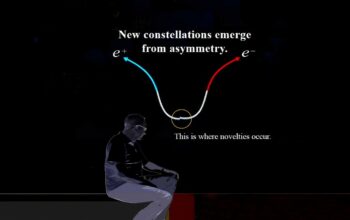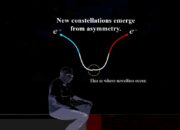In conventional physical theories, matter is classified into ordinary and dark categories. Ordinary matter, which constitutes stars, planets, and human beings, is composed of atoms and interacts with electromagnetic radiation. On the other hand, dark matter, which is estimated to account for approximately 27% of the total mass-energy content of the universe, eludes direct detection through traditional electromagnetic means. Scientists theorize the existence of dark matter based on its gravitational effects on visible matter, but the elusive nature of this entity poses a myriad of challenges in understanding its fundamental characteristics.
The quest for detection of dark matter has sparked innovative methodologies, prompting an investigation into novel detection techniques. Could we, perhaps, conceptualize a “detector with a sixth sense,” one that listens for the elusive signatures of dark matter? This proposition opens up a captivating and scientifically relevant inquiry, encouraging an exploration of unconventional approaches in astrophysics. Listening, a simplistic yet profound sensory activity, could serve as an apt metaphor for our scientific endeavors to discern dark matter’s elusive presence in the cosmos.
To establish a context, it is pertinent to recognize that the existence of dark matter was initially inferred from observations of galactic rotation curves in the 1970s. These curves indicated that stars in spiral galaxies rotate at velocities inconsistent with observable mass, suggesting that additional mass—non-luminous and undetectable by traditional means—was influencing their motion. Subsequent studies have bolstered the case for dark matter through gravitational lensing phenomena, where light from distant galaxies is bent around massive foreground objects, indicating the presence of unseen matter.
Current theoretical frameworks posit several candidates for this elusive form of matter. Among these, Weakly Interacting Massive Particles (WIMPs) are often the prime suspects; they would interact via the weak nuclear force and gravity, making them difficult to detect. However, despite extensive experimentation—such as the use of deep underground laboratories to shield detectors from cosmic rays—WIMPs have yet to be observed directly. This prompts physicists to consider alternative methodologies that transcend conventional detection paradigms.
Exploring the concept of auditory detection as a metaphorical avenue opens up intriguing questions: How might we “listen” for dark matter? Traditional detection methods rely heavily on the emission or absorption of electromagnetic radiation. Yet, an analogy with sound waves suggests an equivalent where the interactions of hypothetical dark matter components could generate auditory signals. This venture into “listening” for dark matter extends across various fronts, including resonances created by dark matter particles colliding with standard matter and generating detectable acoustic or vibrational effects.
One potential framework for this auditory approach could rest on quantum transduction, wherein dark matter interactions produce energy transfer that manifests as sound waves in a detector medium. By embedding sensitive acoustic detectors in environments likely to be influenced by dark matter flux, such as subterranean laboratories or the depths of oceans, researchers could endeavor to capture faint signals. However, the primary challenge surfaces: environmental noise. Distinguishing genuine signals from background noise requires highly refined methodologies capable of mitigating the interference from seismic activities, biological organisms, and other intrinsic vibrations.
To examine this proposition more thoroughly, experiments involving resonant acoustic sensors may benefit from interdisciplinary collaborations. The insights gleaned from fields such as seismology, materials science, and even bioacoustics might foster the advancement of technologies capable of enhancing detection capabilities. The synergy of expertise from varied disciplines can elevate the innovative prospects for sound-based detection methodologies.
Moreover, it is imperative to consider the theoretical implications of such detection mechanisms. An accurate detection of dark matter could unlock profound insights into its properties, providing essential data that refine existing cosmological models. For instance, discoveries related to the mass and interaction cross-sections of dark matter could dictate the structure formation in the universe or influence the evolution of cosmic elements post-Big Bang.
Simultaneously, this exploration underscores the necessity for robust computational simulations that correlate expected dark matter signals with noise characteristics. Leveraging advanced machine learning algorithms may facilitate the identification of dark matter interaction patterns amidst chaotic datasets. Incorporating signal processing techniques, traditionally employed in fields like telecommunications, could serve as invaluable tools in filtering out the irrelevant noise from pertinent data.
The hypothetical “sixth sense” in dark matter detection thus embodies a rich tapestry interwoven from the fabric of theoretical exploration, multidisciplinary collaboration, and innovative detection methodologies. It compels scientists to pose a pivotal question: What audial signatures might dark matter produce, and how can we attune ourselves to perceive those elusive echoes in the cosmic expanse? Mastery of this inquiry embodies a synthesis of creativity and scientific rigor, urging the academic community to pursue pioneering routes in their unrelenting quest for understanding the universe.
Ultimately, the challenge transcends the technical hurdles of designing and implementing such detection systems. It delves into the philosophical realms of how we define perception in the context of scientific inquiry. The quest for dark matter might not only illuminate the hidden constituents of the universe, but it may also redefine our perceptual boundaries, creating a symbiotic relationship between the auditory and the cosmic. As science continues to evolve, it stands to reason that exploring unconventional avenues may yield the breakthroughs necessary to understand one of the universe’s greatest mysteries. Will we eventually listen closely enough to unlock the secrets of dark matter?











